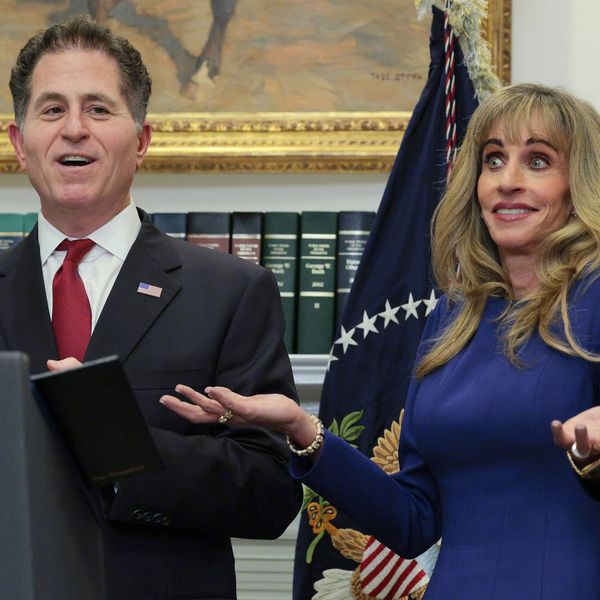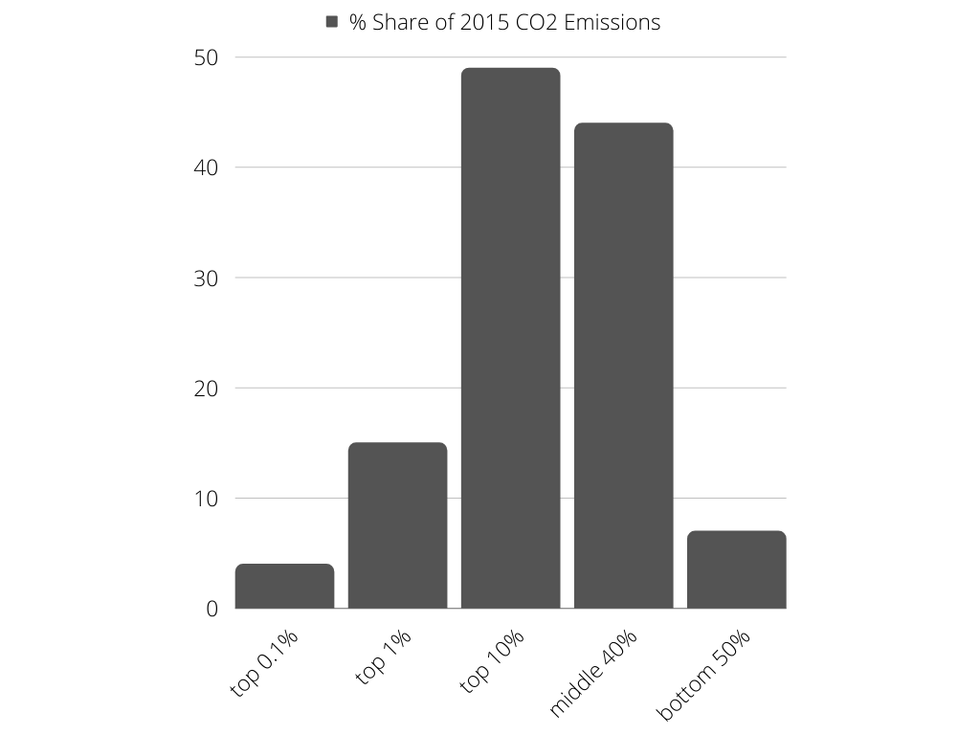
A demonstrator holds a "Tax the Rich" sign during a protest in New York on June 27, 2020. (Photo: Erik McGregor/LightRocket via Getty Images)
It's Time for a Global Billionaire and Millionaire Wealth Tax to Save Our Living Planet
The next time you hear someone say it is impossible to solve the climate and biodiversity crises, let them know that the only thing impossible is governments actually acting without massive grassroots pressure.
Our politicians, flush from millionaire/billionaire campaign "contributions," like to pretend that the cost of dealing with the climate and biodiversity crises is prohibitively expensive and pretend that we should wait until the cost of solutions come down before we act, but is this really true?
In their 2019 Emissions Gap Report, the U.N. states that transitioning to a zero-carbon economy by 2050 will cost between $1.6-$3.8 trillion annually. While this is an enormous amount of money, to put it into context, $16.7 trillion was spent globally by May 2021 on COVID-19 measures. It is also worth noting that should global temperatures warm by 2degC, then the cost to the global economy is estimated at between $10-$20 trillion a year, a fivefold increase. The cost of action will rise each year governments drag their feet. It will never be cheaper than $1.6-$3.8 trillion.
Now we have seen what it will cost, the big question should be where this funding comes from? One source of funding could come from military budgets which total approximately $2 trillion a year and contribute around 6% of global CO2 emissions. As military budgets are sold to citizens as a defense strategy, their use to defend us from runaway climate chaos is clearly warranted. A further source of funding, and one that is equally justified, is a global wealth tax on millionaires and billionaires. Why is this justified? Well, research is clear that emissions are closely correlated with wealth, and as we live in a world where we are taught to be responsible for our actions, it seems fair that the more you have contributed to the problem, the more you should pay to solve it. Research by Oxfam and the Stockholm Environment Institute found that the richest 10% (over $38,000) were responsible for 49% of emissions, the richest 5% contributed 37% of emissions while the wealthiest 1% (over $109,000) created around 15%. The poorest 50% of humanity contributed almost nothing. This should be enough evidence to refute the often-cited words that "population is the problem". If the top half of earners lived like the bottom 50% then global emissions would be just 14% of their current total and could be balanced through natural carbon sequestration.
Figure 2 Share of total carbon emissions (%)
Now that we understand the cost of solving the crisis, and we know that the wealthier you are, the more you have contributed to the planetary crisis unfolding, could we now work out how much the wealthy need to pay in order to fund a transition to a zero-carbon economy? A 2022 report from OXFAM, Patriotic Millionaires, the Institute for Policy Studies and Fight Inequality has done just that.
They calculate that there are 3.6 million citizens with more than $5 million in the bank, 183,000 citizens with more $50 million and there are 2,660 billionaires. According to their findings, if we were to tax these global citizens at 2, 3 and 5% respectively we could raise $2.52 trillion. If we added slightly higher tax rates of 2, 5 and 10% then $3.62 trillion could be raised annually. A simple wealth tax on those who have contributed the most and can easily afford it would be enough to fund the U.N. estimated zero-carbon transition. It wouldn't need to saddle future generations with any debt. Should governments start to take our predicament seriously and decide that 2050 is far too late to keep warming within 1.5degC, then we could add the money from the global wealth tax to global military budgets and we would have $5.62 trillion to fund a rapid transition.
Figure 3 Global Wealth Breakdown
There is an extra step that once again won't cost the average citizen anything and is extremely befitting; the reallocation of fossil fuel subsidies worth $5 trillion a year. Should we use these subsidies to fuel the growth of renewable energy and plant-based protein alternatives, our climate and biodiversity war chest would total around $10.62 trillion, almost thrice the U.N. estimate for economic decarbonization.
The next time you hear someone say it is impossible to solve the climate and biodiversity crises, let them know that the only thing impossible is governments actually acting without massive grassroots pressure. If we can terraform a hostile red planet 330.47 million km away, we can certainly fund the transition to a zero-carbon economy on Earth.
An Urgent Message From Our Co-Founder
Dear Common Dreams reader, The U.S. is on a fast track to authoritarianism like nothing I've ever seen. Meanwhile, corporate news outlets are utterly capitulating to Trump, twisting their coverage to avoid drawing his ire while lining up to stuff cash in his pockets. That's why I believe that Common Dreams is doing the best and most consequential reporting that we've ever done. Our small but mighty team is a progressive reporting powerhouse, covering the news every day that the corporate media never will. Our mission has always been simple: To inform. To inspire. And to ignite change for the common good. Now here's the key piece that I want all our readers to understand: None of this would be possible without your financial support. That's not just some fundraising cliche. It's the absolute and literal truth. We don't accept corporate advertising and never will. We don't have a paywall because we don't think people should be blocked from critical news based on their ability to pay. Everything we do is funded by the donations of readers like you. Will you donate now to help power the nonprofit, independent reporting of Common Dreams? Thank you for being a vital member of our community. Together, we can keep independent journalism alive when it’s needed most. - Craig Brown, Co-founder |
Our politicians, flush from millionaire/billionaire campaign "contributions," like to pretend that the cost of dealing with the climate and biodiversity crises is prohibitively expensive and pretend that we should wait until the cost of solutions come down before we act, but is this really true?
In their 2019 Emissions Gap Report, the U.N. states that transitioning to a zero-carbon economy by 2050 will cost between $1.6-$3.8 trillion annually. While this is an enormous amount of money, to put it into context, $16.7 trillion was spent globally by May 2021 on COVID-19 measures. It is also worth noting that should global temperatures warm by 2degC, then the cost to the global economy is estimated at between $10-$20 trillion a year, a fivefold increase. The cost of action will rise each year governments drag their feet. It will never be cheaper than $1.6-$3.8 trillion.
Now we have seen what it will cost, the big question should be where this funding comes from? One source of funding could come from military budgets which total approximately $2 trillion a year and contribute around 6% of global CO2 emissions. As military budgets are sold to citizens as a defense strategy, their use to defend us from runaway climate chaos is clearly warranted. A further source of funding, and one that is equally justified, is a global wealth tax on millionaires and billionaires. Why is this justified? Well, research is clear that emissions are closely correlated with wealth, and as we live in a world where we are taught to be responsible for our actions, it seems fair that the more you have contributed to the problem, the more you should pay to solve it. Research by Oxfam and the Stockholm Environment Institute found that the richest 10% (over $38,000) were responsible for 49% of emissions, the richest 5% contributed 37% of emissions while the wealthiest 1% (over $109,000) created around 15%. The poorest 50% of humanity contributed almost nothing. This should be enough evidence to refute the often-cited words that "population is the problem". If the top half of earners lived like the bottom 50% then global emissions would be just 14% of their current total and could be balanced through natural carbon sequestration.
Figure 2 Share of total carbon emissions (%)
Now that we understand the cost of solving the crisis, and we know that the wealthier you are, the more you have contributed to the planetary crisis unfolding, could we now work out how much the wealthy need to pay in order to fund a transition to a zero-carbon economy? A 2022 report from OXFAM, Patriotic Millionaires, the Institute for Policy Studies and Fight Inequality has done just that.
They calculate that there are 3.6 million citizens with more than $5 million in the bank, 183,000 citizens with more $50 million and there are 2,660 billionaires. According to their findings, if we were to tax these global citizens at 2, 3 and 5% respectively we could raise $2.52 trillion. If we added slightly higher tax rates of 2, 5 and 10% then $3.62 trillion could be raised annually. A simple wealth tax on those who have contributed the most and can easily afford it would be enough to fund the U.N. estimated zero-carbon transition. It wouldn't need to saddle future generations with any debt. Should governments start to take our predicament seriously and decide that 2050 is far too late to keep warming within 1.5degC, then we could add the money from the global wealth tax to global military budgets and we would have $5.62 trillion to fund a rapid transition.
Figure 3 Global Wealth Breakdown
There is an extra step that once again won't cost the average citizen anything and is extremely befitting; the reallocation of fossil fuel subsidies worth $5 trillion a year. Should we use these subsidies to fuel the growth of renewable energy and plant-based protein alternatives, our climate and biodiversity war chest would total around $10.62 trillion, almost thrice the U.N. estimate for economic decarbonization.
The next time you hear someone say it is impossible to solve the climate and biodiversity crises, let them know that the only thing impossible is governments actually acting without massive grassroots pressure. If we can terraform a hostile red planet 330.47 million km away, we can certainly fund the transition to a zero-carbon economy on Earth.
Our politicians, flush from millionaire/billionaire campaign "contributions," like to pretend that the cost of dealing with the climate and biodiversity crises is prohibitively expensive and pretend that we should wait until the cost of solutions come down before we act, but is this really true?
In their 2019 Emissions Gap Report, the U.N. states that transitioning to a zero-carbon economy by 2050 will cost between $1.6-$3.8 trillion annually. While this is an enormous amount of money, to put it into context, $16.7 trillion was spent globally by May 2021 on COVID-19 measures. It is also worth noting that should global temperatures warm by 2degC, then the cost to the global economy is estimated at between $10-$20 trillion a year, a fivefold increase. The cost of action will rise each year governments drag their feet. It will never be cheaper than $1.6-$3.8 trillion.
Now we have seen what it will cost, the big question should be where this funding comes from? One source of funding could come from military budgets which total approximately $2 trillion a year and contribute around 6% of global CO2 emissions. As military budgets are sold to citizens as a defense strategy, their use to defend us from runaway climate chaos is clearly warranted. A further source of funding, and one that is equally justified, is a global wealth tax on millionaires and billionaires. Why is this justified? Well, research is clear that emissions are closely correlated with wealth, and as we live in a world where we are taught to be responsible for our actions, it seems fair that the more you have contributed to the problem, the more you should pay to solve it. Research by Oxfam and the Stockholm Environment Institute found that the richest 10% (over $38,000) were responsible for 49% of emissions, the richest 5% contributed 37% of emissions while the wealthiest 1% (over $109,000) created around 15%. The poorest 50% of humanity contributed almost nothing. This should be enough evidence to refute the often-cited words that "population is the problem". If the top half of earners lived like the bottom 50% then global emissions would be just 14% of their current total and could be balanced through natural carbon sequestration.
Figure 2 Share of total carbon emissions (%)
Now that we understand the cost of solving the crisis, and we know that the wealthier you are, the more you have contributed to the planetary crisis unfolding, could we now work out how much the wealthy need to pay in order to fund a transition to a zero-carbon economy? A 2022 report from OXFAM, Patriotic Millionaires, the Institute for Policy Studies and Fight Inequality has done just that.
They calculate that there are 3.6 million citizens with more than $5 million in the bank, 183,000 citizens with more $50 million and there are 2,660 billionaires. According to their findings, if we were to tax these global citizens at 2, 3 and 5% respectively we could raise $2.52 trillion. If we added slightly higher tax rates of 2, 5 and 10% then $3.62 trillion could be raised annually. A simple wealth tax on those who have contributed the most and can easily afford it would be enough to fund the U.N. estimated zero-carbon transition. It wouldn't need to saddle future generations with any debt. Should governments start to take our predicament seriously and decide that 2050 is far too late to keep warming within 1.5degC, then we could add the money from the global wealth tax to global military budgets and we would have $5.62 trillion to fund a rapid transition.
Figure 3 Global Wealth Breakdown
There is an extra step that once again won't cost the average citizen anything and is extremely befitting; the reallocation of fossil fuel subsidies worth $5 trillion a year. Should we use these subsidies to fuel the growth of renewable energy and plant-based protein alternatives, our climate and biodiversity war chest would total around $10.62 trillion, almost thrice the U.N. estimate for economic decarbonization.
The next time you hear someone say it is impossible to solve the climate and biodiversity crises, let them know that the only thing impossible is governments actually acting without massive grassroots pressure. If we can terraform a hostile red planet 330.47 million km away, we can certainly fund the transition to a zero-carbon economy on Earth.



